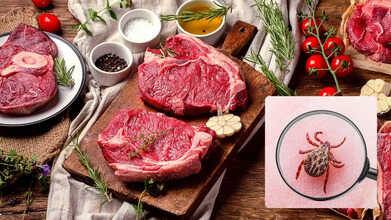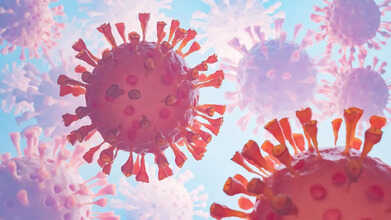- Health Conditions A-Z
- Health & Wellness
- Nutrition
- Fitness
- Health News
- Ayurveda
- Videos
- Medicine A-Z
- Parenting
How Can I Treat My Cold Sores?

Credits: Canva
Cold sores are a common and often frustrating skin issue. While they may look like harmless blisters, cold sores are actually caused by the herpes simplex virus (HSV).
What Causes Cold Sores?
Cold sores are caused by the herpes simplex virus (HSV), which comes in two types: HSV-1 and HSV-2.
HSV-1 is the primary cause of cold sores, usually appearing around the mouth.
HSV-2 generally causes genital herpes but can also lead to cold sores.
While the appearance of cold sores caused by both HSV-1 and HSV-2 can look similar, their locations tend to differ. However, it is possible for HSV-1 to cause sores on the genitals and for HSV-2 to appear on the mouth.
How Do Cold Sores Spread?
Cold sores are highly contagious and can spread easily. The virus can be passed on through:
- Kissing or skin contact
- Sharing food, drinks, or cosmetics (such as lip balm)
- Oral sex, which can spread both cold sores and genital herpes
Even when a cold sore isn’t visible, the virus can still be spread through close contact. This makes prevention and management key to reducing outbreaks and the risk of infecting others.
Once someone contracts HSV, it stays in the body for life. While the virus remains dormant most of the time, it can reactivate and cause new sores, especially during periods of:
- Stress
- Illness
- A weakened immune system
Unfortunately, there’s no cure for the herpes virus, but the symptoms can be managed.
Symptoms of Cold Sores
Cold sores don’t just appear out of nowhere. Before the sore is visible, you may notice a tingling or burning sensation around the lips or face, which can occur several days before the sore forms. This is the best time to begin treatment to shorten the outbreak.
When a cold sore does appear, it often looks like a red, raised blister filled with fluid. The blister can be painful to touch, and there may be more than one. Cold sores usually last around two weeks and are contagious until they crust over and heal.
The Five Stages of a Cold Sore
Cold sores go through distinct stages as they develop and heal:
- Tingling and itching: You may feel these symptoms about 24 hours before the blister appears.
- Blisters: Small, fluid-filled blisters form, typically around the mouth.
- Bursting: The blisters burst and form painful sores.
- Scabbing: The sores dry out, scab over, and may itch or crack.
- Healing: The scab falls off, and the cold sore heals.
Risk Factors for Cold Sores
Certain factors can trigger the reactivation of HSV, leading to cold sores. These include:
- Infection, fever, or cold
- Sun exposure
- Stress
- Menstruation
- Dental work or injury
- Weakened immune system due to conditions like HIV/AIDS, eczema, or chemotherapy
Managing and Treating Cold Sores
There’s no cure for cold sores, but several treatments can ease the symptoms and help manage outbreaks.
Topical Ointments and Creams
Over-the-counter antiviral creams like docosanol (Abreva) or prescription ointments like penciclovir (Denavir) can help reduce the duration of an outbreak, especially if applied at the first sign of a cold sore.
Oral Medications
Prescription antiviral medications like acyclovir, valacyclovir, and famciclovir can also help, particularly for people who have frequent or severe outbreaks. Your doctor may recommend taking these medications regularly to prevent future outbreaks.
Home Remedies
There are also some home remedies that may provide relief, such as:
- Applying ice or a cold washcloth to the sore
- Using aloe vera gel or lemon balm lip balms
- Applying petroleum jelly to ease discomfort
Canker Sores vs. Cold Sores: What's the Difference?
While cold sores and canker sores may seem similar, they are quite different:
Cold sores are caused by the herpes virus, appear around the mouth, and are contagious.
Canker sores are not contagious and appear as ulcers inside the mouth or throat.
Preventing the Spread of Cold Sores
To avoid spreading cold sores:
- Wash your hands frequently
- Avoid close contact with others during an outbreak
- Don’t share food, drinks, or personal items like lip balm
Cold sores can be a persistent issue, but with proper care and management, you can reduce the frequency of outbreaks and prevent spreading the virus to others.
Lone Star Tick: All You Need To Know About The Bite Linked To A Life-Threatening Meat Allergy

Lone Star Tick disease: Scientists have verified the first known death tied to a serious meat allergy brought on by a tick bite. The man, who passed away in 2024 after eating a burger, had alpha-gal syndrome. This condition begins after certain tick bites and leads to dangerous allergic reactions to red meat and other foods made from animals. Two weeks before his death, he had already reacted badly after eating a steak.
“The sad part is that no one recognised that earlier incident as anaphylaxis, so it was never linked to the beef,” said study co-author Thomas Platts-Mills, an allergist at the University of Virginia School of Medicine who helped identify alpha-gal syndrome and diagnosed the New Jersey case, during an interview with NBC News. But how did he develop this condition in the first place?
Lone Star Tick: What Are Lone Star Ticks?
A tick marked with a small white dot is known as the lone star tick (Amblyomma americanum). Many people already know that certain tick species can threaten human health. Lone star ticks are mainly found in Texas and Oklahoma, stretching across the Southern states and moving up the Atlantic coastline to parts of Maine. They live in wooded regions and are most common from April to September.
Falling ill after a lone star tick bite can take several days or even a few weeks. A bite can trigger various problems, including a serious meat allergy known as alpha-gal syndrome.
Lone Star Tick: What Is Alpha Gal Syndrome?
Bites from lone star ticks can lead to another major effect. The bite can cause the body to develop an allergy to meat. Substances from the tick, including alpha-gal, enter the bloodstream when it bites, which alerts the immune system and prompts the body to create antibodies to the alpha-gal molecule. Humans do not naturally produce this sugar, so the body treats it as foreign.
This reaction can make a person allergic to the sugar. Alpha-gal is present in many common foods, including beef, pork, lamb, dairy products, and gelatin. Once the allergy develops, a person can fall sick after eating these foods.
Experts believe that many people with alpha-gal syndrome have no idea they carry it. In the New Jersey case, it took scientists months to confirm that the man had the syndrome and had died as a result of it. Warmer winters have also allowed ticks to remain active for longer periods, raising the chances of bites throughout the year.
Anyone who thinks they may have this allergy can undergo testing to check. Although there is no cure for alpha-gal syndrome, doctors advise people with the condition to avoid all forms of meat, as well as dairy, gelatin, and some medicines that include these ingredients.
Lone Star Tick: How To Know if You Have the Alpha-Gal Allergy
Many people never realise they were bitten, unless a rash becomes visible. The symptoms of alpha-gal syndrome vary widely and may take weeks to appear, which makes it difficult to diagnose.
Signs of an alpha-gal allergy can include gastrointestinal discomfort after eating foods such as:
- Dairy products, which trouble about 10 to 20 percent of individuals with the allergy
- Red meats like beef, pork, lamb, or venison
- Foods and items that contain gelatin
Other signs may involve hives or, in severe situations, anaphylaxis. The allergy can take four to six weeks to form after the tick bite. Reactions may also be delayed for several hours after a person eats the food that triggers it.
A healthcare professional can test for the alpha-gal IgE antibody through a blood sample. Food challenge tests may also be carried out under medical supervision, in case a severe reaction occurs.
When Is The Best Time To Take Your Blood Pressure Medicine?

Credits: Canva
Doctors usually recommend taking daily medications in the morning, making it part of a morning routine. However, recent research suggests that taking blood pressure (BP) medications at night may provide additional cardiovascular protection. Still, consistency like taking your BP medicine at the same time every day—is more important than whether it’s morning or evening.
Numerous studies have examined the timing of BP medications, but none have produced conclusive evidence favoring morning or evening doses. To gain more insight, we spoke with Dr. Kiran Aithal, Vice Principal, Professor, and HOD of General Medicine at SDMCMS&H, SDM University, Dharwad who shared his perspective on the topic.
When Is The Best Time To Take Blood Pressure Medicine?
One of the largest trials, including over 21,000 participants, did not find clear evidence that taking BP medication in the morning is superior to taking it at night. Dr. Kiran suggests linking the timing to a daily activity that’s hard to forget, like breakfast or dinner, so doses aren’t missed. Skipping a dose is a common reason for hypertensive emergencies.
Dr Kiran said, “Sometimes, patients on multiple BP medications may need to split doses between morning and night, following the doctor’s instructions. Certain drugs, such as diuretics, are advised in the morning as they can increase urination. In some patients whose blood pressure doesn’t naturally dip at night (detectable through Ambulatory BP monitoring), physicians may recommend taking medication at night to achieve better control. Following your doctor’s advice is key.”
In general, most BP medications can be taken either in the morning or evening. The critical factor is taking them consistently at the same time every day to prevent complications. It’s important to remember that hypertension cannot be cured but can be effectively controlled. Lifestyle changes combined with regular, timely medication are crucial for managing high blood pressure successfully.
What Should You Avoid While Taking Blood Pressure Medicine?
Certain foods, drinks, and medications can interfere with blood pressure medicines. These include grapefruit juice, high-potassium foods, and salt substitutes, as well as alcohol and caffeine. Over-the-counter drugs like decongestants and NSAIDs (such as ibuprofen or naproxen) should also be avoided.
Some herbal supplements, including St. John’s Wort and licorice, can affect your blood pressure, and recreational drugs should be completely avoided. Always check with your doctor or pharmacist before starting any new medication, supplement, or making significant changes to your diet, says the Heart Organisation.
Understanding Blood Pressure Categories
Blood pressure is measured using two numbers: systolic (the top number) and diastolic (the bottom number). Based on these readings, blood pressure is classified as normal, elevated, or high. A normal reading is below 120/80 mmHg. Elevated blood pressure falls between 120–129 systolic with a diastolic under 80. Stage 1 hypertension is defined as 130–139 systolic or 80–89 diastolic, while Stage 2 hypertension is 140 or higher systolic or 90 or higher diastolic.
Readings of 180/120 or above are considered a hypertensive crisis and require immediate medical attention, according to the Heart Organisation.
Disclaimer: This article is for informational purposes only and is not a substitute for professional medical advice, diagnosis, or treatment. Always consult your healthcare provider before making any changes to your medication, diet, or lifestyle.
Subclade K Flu Variant Explained: Symptoms, Risks, And How To Stay Safe

Credits: Canva
Flu season has arrived earlier than expected in the U.K., with cases starting to rise in October, over a month before epidemiologists typically anticipate the season to begin. Fueling this surge is a new flu variant, which, while flu viruses constantly evolve, has accumulated an unusually high number of mutations in a short span.
“This strain has changed faster than usual, showing more mutations than we typically observe,” explains Jamie Lopez Bernal, a consultant epidemiologist at the U.K. Health Security Agency (UKHSA).
What Is Subclade K?
The new variant is called influenza A subtype H3N2 subclade K, often shortened to “subclade K,” and it has also been detected in Japan, where authorities declared a flu epidemic last month.These mutations make the virus slightly different from the components included in this year’s updated flu vaccines. At the end of October, Canadian scientists highlighted that the changes needed close monitoring, including regular sequencing of the virus and evaluation of whether current vaccines remain effective.
On November 12, Lopez Bernal and the UKHSA team shared early findings suggesting that, so far, vaccination continues to offer significant protection against hospitalization and severe illness.
Still, the level of protection resembles what is usually seen late in the flu season, when the vaccine’s effectiveness naturally decreases and the mismatch between the virus and the vaccine rises.
Subclade K Symptoms
The subclade K (H3N2) flu variant causes the same classic flu symptoms, though some doctors have observed that it may lead to more severe illness in some cases. There are no symptoms unique to subclade K; the main concern is its rapid spread and ability to bypass some immunity, according to the NHS.
Typical flu symptoms associated with subclade K include:
- Sudden high fever and chills
- Fatigue and overall weakness
- Headache
- Muscle aches and pains
- Dry, chesty cough
- Sore throat
- Runny or blocked nose
- Loss of appetite
- Trouble sleeping
- Diarrhea or vomiting (more common in children)
Is Subclade K In The U.S.?
During the U.S. government shutdown, the flu-tracking site run by the Centers for Disease Control and Prevention has not been updated. As of Nov. 13, the most recent data is from late September, when flu activity was low.
However, the New York State Department of Health reported that for the week ending Nov. 1, laboratory-confirmed flu cases had risen by 49% from the previous week, and hospitalizations were up 71%, matching roughly the levels from the same time last year. These figures don’t include subtyping, so it’s unclear whether the subclade K variant has reached the U.S. yet.
Subclade K Flu: How To Stay Safe
Vaccination remains the best defense against the flu. Influenza claims thousands of lives annually and poses a particular threat to children and older adults.
“Children are at higher risk of serious illness from flu, so it’s crucial they get vaccinated. This also protects their relatives, especially vulnerable or elderly family members who may be exposed,” advises Lopez Bernal of the UK Health Security Agency. Even with the mutations seen in this new variant, the vaccine remains a key tool in protecting against severe disease.
© 2024 Bennett, Coleman & Company Limited

